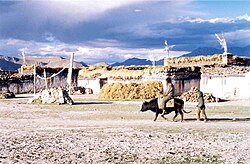Tingri County
定日县 • དིང་རི་རྫོང་། Dhringgri | |
|---|---|
 | |
 Location of Tingri County (red) within Xigazê City (yellow) and the Tibet Autonomous Region | |
| Coordinates (Tingri County government, Shelkar): 28°39′32″N 87°07′34″E / 28.659°N 87.126°E | |
| Country | China |
| Autonomous region | Tibet |
| Prefecture-level city | Xigazê |
| County seat | Shelkar |
| Area | |
• Total | 13,861.21 km2 (5,351.84 sq mi) |
| Population (2020)[1] | |
• Total | 58,173 |
| • Density | 4.2/km2 (11/sq mi) |
| Time zone | UTC+8 (China Standard) |
| Website | www |
| Tingri County | |||||||
|---|---|---|---|---|---|---|---|
| Chinese name | |||||||
| Simplified Chinese | 定日县 | ||||||
| Traditional Chinese | 定日縣 | ||||||
| |||||||
| Tibetan name | |||||||
| Tibetan | དིང་རི་རྫོང་། | ||||||
| |||||||
Tingri County (Tibetan: དིང་རི་རྫོང་།; Chinese: 定日县) is a county under the administration of the prefecture-level city of Xigazê in the Tibet Autonomous Region of China.[2]
The county comprises the upper valley of the Bum-chu or Arun River, with the valleys of its tributaries, the valleys of the Rongshar Tsangpo and the Lapchi Gang Tsanpo which flow south into Nepal. It is bordered on the south by the main range of the Himalayas, including Mount Everest (Tib. Chomolungma), Makalu and Cho Oyu. The present county administration is located at Shelkar, about 87 km (54 mi) east of Tingri (town).[3]
Tingri is one of the four counties (the other three being Dinjie, Nyalam, and Kyirong) that comprise the Qomolangma National Nature Preserve,[4] a protected area spanning 3.381 million hectares.
- ^ "日喀则市第七次全国人口普查主要数据公报" (in Chinese). Government of Xigazê. 2021-07-20.
- ^ Croddy, E. (2022). China’s Provinces and Populations: A Chronological and Geographical Survey. Springer International Publishing. p. 698. ISBN 978-3-031-09165-0. Retrieved 2024-03-07.
- ^ Footprint Tibet Handbook with Bhutan, p. 296. 2nd edition (1999). Gyume Dorje. Footprint Handbooks, Bath, England. ISBN 1-900949-33-4.
- ^ Department of Forestry, Government of the Tibet Autonomous Region, People's Republic of China, ‘’Report on Protected Lands in the Tibet Autonomous Region’’ Lhasa: Tibet Autonomous Region Government Publishing House, 2006

